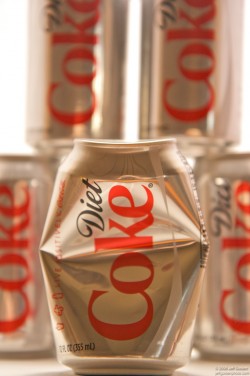 What evil lurks in that can of refreshment?Photo: Jeff GoldenTurns out, it’s not just the fake sweetener in Diet Pepsi and Diet Coke that might cause cancer; it’s also the coloring agent. The cans these beverages come in aren’t so healthy, either.
What evil lurks in that can of refreshment?Photo: Jeff GoldenTurns out, it’s not just the fake sweetener in Diet Pepsi and Diet Coke that might cause cancer; it’s also the coloring agent. The cans these beverages come in aren’t so healthy, either.
Modern-day commercial colas (both diet and regular) get their characteristic dark hue from something manufacturers call “caramel color.” On Wednesday, the Center for Science in the Public Interest formally petitioned the FDA to ban the chemicals that fall under that ambiguous label, on the grounds that they’ve been shown to be carcinogenic.
Wait, the FDA is allowing a cancer-causing substance to be used widely by the food industry and consumed by millions of people daily, without warning?
Evidently so. Indeed, to illustrate the difficulty our regulatory institutions face in trying to protect the public health against intense industry pressure to do nothing, I can think of no finer example than a simple can of diet cola.
As I pointed out in two recent posts, the sweetener in most commercial diet sodas is aspartame, a substance that won FDA approval under dodgy circumstances and continues to be dogged by studies that find it carcinogenic.
Moreover, the container soda typically comes in is itself deeply problematic. Nearly all cans used by the U.S. beverage industry contain bisphenol A, commonly known as BPA. Here’s how Scientific American describes it: “In recent years dozens of scientists around the globe have linked BPA to myriad health effects in rodents: mammary and prostate cancer, genital defects in males, early onset of puberty in females, obesity, and even behavior problems such as attention-deficit hyperactivity disorder.”
The Canadian government recently declared BPA toxic. A peer-reviewed study financed by health-care giant Kaiser Permanante found that BPA is associated with “decreased sexual desire [among men], more difficulty having an erection, lower ejaculation strength and lower level of overall satisfaction with sex life.”
What’s the FDA doing to get it out of our cans? Not much of anything, as Tom Laskawy reported last year. For an in-depth look at the agency’s dithering, contradictory approach to BPA, check out its own report on the topic. Short version: BPA is pretty scary, but it’s so widely used, and used in so many forms, we haven’t the foggiest idea of how to remove it from the food supply. So we won’t try.
So Diet Coke and its brethren get their flavor from a dodgy sweetener and are packaged in a dodgy vessel. And now the Center for Science in the Public Interest is telling us that its color, too, can kill us. How bad is it? When you think of “caramel,” you probably imagine cooking sugar until it turns brown. But that’s not quite what soda manufacturers do to blacken carbonated water for cola. According to CSPI, here’s what they do:
Caramel Color IV (synonyms: ammonia sulfite process caramel, sulfite ammonia caramel, sulfite ammonia process caramel, acid-proof caramel, beverage caramel, and soft-drink caramel) is prepared by the controlled heat treatment of carbohydrates with ammonium-containing and sulfite-containing compounds.
So, they take carbohydrates and cook them up with ammonia-based chemicals. In addition to dark color, the process also yields a carcinogenic chemical called 4-methylimidazole, or 4-MI for short. CSPI points to studies on both rats and mice fed 4-MI showing significant carcinogenic effects.
Evidence of 4-MI’s cancer-causing power is so strong, CSPI points out, that just last month, the state of California added [PDF] the substance to its list of “chemicals known to the state to cause cancer.” “California has determined that [4-MI] levels above 16 micrograms per day pose a significant risk,” CSPI reports. How much is in a can of cola? According to CSPI, 130 micrograms — eight times higher than California’s danger threshold. Drink two cans per day, and you’re ingesting 16 times the level deemed dangerous by California.
When I was posting about these topics this morning on Twitter, one response I got was an exasperated, “Is anything safe?” Well, yes, there are plenty of things that are safe to consume. It’s just that diet — and regular — sodas are evidently full of unsafe substances, and should probably be avoided. If the FDA were doing its job, the millions of people who consume these substances daily would at least know what they’re subjecting themselves to.
It’s worth reviewing the ingredients list for Diet Pepsi:
CARBONATED WATER, CARAMEL COLOR, ASPARTAME, PHOSPHORIC ACID, POTASSIUM BENZOATE (PRESERVES FRESHNESS), CAFFEINE, CITRIC ACID, NATURAL FLAVOR
That the industry gets millions of people to habitually consume such a thing stands as an epic triumph of marketing. That the FDA allows the industry to infuse it with so many evident poisons stands as an epic failure of public oversight.



